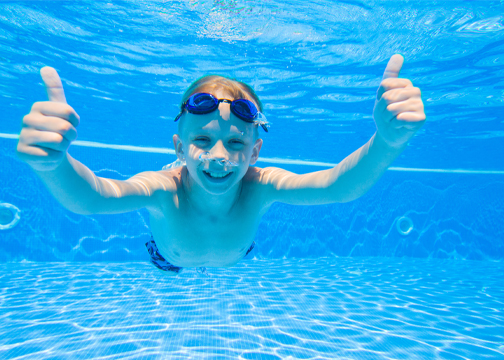Guide: How to Switch from Chlorine to Salt for your Pool
Are you a pool owner who no longer wants to use harsh chemicals? Tired of the maintenance required for a chlorinated pool? Consider switching to a saltwater pool!
Saltwater pools offer a more natural bathing experience, with water that’s gentler on skin, hair and eyes. What’s more, they require less maintenance and are more environmentally friendly.
But how do you switch from chlorine to salt? Here’s a step-by-step guide to get you started!
Discover our pool salt, available at many retailers.
1. What’s the difference between chlorine and salt pools?
Before making the switch, it’s important to understand the differences between the two types of pools.
Chlorine pools require the regular addition of chlorine to maintain the right level of disinfectant in the water.
Saltwater pools, on the other hand, use a salt chlorine generator to convert salt into chlorine, which then sanitizes the pool. While both types of pool require maintenance, saltwater pools require less frequent attention and have lower long-term maintenance costs.
2. Check Your Pool Equipment
Before converting your pool to a saltwater system, it’s important to ensure that your pool equipment is compatible.
Saltwater pools require a salt chlorine generator, which is installed with your pool’s piping system. Make sure your pool pump and filter are in good condition and are the right size for your pool.
Changing your pool’s filtration mode is the perfect time to reassess the condition of your equipment. You definitely want to get this project off to a good start!
3. Determine the Right Size of Salt Chlorine Generator
Salt chlorine generators come in different sizes (depending on the size of your pool). It’s important to choose the right size of generator to ensure that your pool is properly disinfected. A generator that’s too small won’t be able to produce enough chlorine, while one that’s too big will incur unnecessary extra costs.
Make sure you know the dimensions of your pool when buying a salt chlorine generator. The professionals who advise you will then be able to recommend the right device.
4. Calculate the Amount of Salt Required
Saltwater pools need salt to function, but not just any kind. You need to use a salt specifically designed for pools.
The amount of salt you need depends on the size of your pool, the manufacturer’s recommendations and the level of salinity you wish to achieve. Generally speaking, you’ll need about 50 lb (22.67 kg) of salt for 2,000 gallons (7,570 litres) of water.
It’s important to know the volume of water in your pool!
Here are a few examples to help you visualize different volumes:
|
Dimension |
Gallons |
Litres |
|
15’ |
5,200 |
19,684 |
|
18' |
7,600 |
28,769 |
|
21’ |
10,400 |
39,369 |
|
24’ |
13,500 |
51,102 |
|
27’ |
17,200 |
65,108 |
5. Empty and Clean your Pool
Before converting your pool to a saltwater system, you’ll need to drain and clean it. This will remove any debris, algae or other contaminants that could interfere with the new saltwater system. Use a pool brush to scrub the sides and bottom, and vacuum up any debris that settles at the base.
6. Install the Salt Chlorine Generator
Once your pool has been drained and cleaned, it’s time to install the salt chlorine generator. This device attaches directly to your pool’s plumbing system and converts salt into chlorine.
Follow the manufacturer’s instructions carefully to ensure that the generator is installed correctly. Don’t hesitate to ask for professional help if needed.
7. Add Salt to Your Pool
Now that the salt chlorine generator has been installed, it’s time to add salt to your pool. Add it gradually, spreading it evenly over the entire surface of your pool. Use a pool brush to stir the water and help dissolve the salt.
8. Test the Water
Time to test the water! This step is important to ensure that the salinity level is perfect. Use a saltwater test kit to measure the salinity level, and adjust the salt level if necessary.
9. Start the New System
Salt level is adjusted? It’s time to start the salt chlorine generator. Follow the manufacturer’s instructions to switch on the generator and set it to the right power level for your pool.
10. Supervise and Maintain Your Pool
Your chlorine pool is now switched to saltwater! But your work doesn’t stop there. You’ll need to constantly monitor and maintain your pool to make sure the water stays clean and safe. Here are a few tips to keep your saltwater pool in top condition:
- Test water regularly: use a pool test kit to regularly measure chlorine levels, pH levels and alkalinity (amount of mineral salts present in water). This will confirm that water is well balanced and clean for swimming.
- Clean the pool regularly: like a chlorinated pool, a saltwater pool needs regular cleaning. Use a brush and vacuum to clean the walls and bottom. This will prevent algae growth.
- Adjust the chlorine level as needed: depending on the weather, the number of regular swimmers and other factors, you may need to adjust the chlorine level in your pool.
- Add salt if necessary: over time, some of the salt in your pool may be lost through evaporation or splashing. Test the water regularly and add salt as required to maintain the correct salinity level.
Enjoy your Swim!
By following these steps and performing regular maintenance, you can enjoy a clean, clear and environmentally friendly saltwater pool all summer long!
Feel free to contact us for all questions about your pool filtration media.
Did you know that you have other options? Here’s an article to help you choose between sand and glass for pool filtration.
